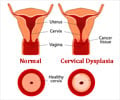
‘About 5.5 million women would be killed from cancer each year by 2030, much higher than 3.5 million deaths from 6.7 million cancer cases recorded in 2012.’
Tweet it Now
Five-year survival after diagnosis of breast cancer ranges from around 50 percent in South Africa, Mongolia, and India, to over 80 percent in 34 countries, including Australia, the UK, Ireland, France, Germany and the US, highlighting huge inequalities in access to prevention, early detection, and treatment. Persistent underinvestment in low- and middle-income countries, which receive just 5 percent of global funding for cancer, has exacerbated the issue.
Further, with many competing health priorities in low-and-middle-income countries, services for women's cancers are given low priority and allocated few resources.
Also, "there is a widespread misconception that breast and cervical cancers are too difficult and expensive to prevent and treat, particularly in resource-poor countries where the burden of these diseases is highest," said lead author Ophira Ginsburg, a professor at the University of Toronto, Canada.
Breast and cervical cancer are not inevitably fatal and can be prevented and treated, say the authors, particularly if they are detected and treated at an early stage, the researchers observed.
Advertisement
Cervical cancer, for example, is almost entirely preventable thanks to cost-effective routine human papillomavirus (HPV) vaccination of girls and cervical screening with treatment of pre-cancers, neither of which require oncologists, or specialist cancer centers, and can prevent 600,000 future cervical cancer deaths in the world's poorest countries over the next four years.
Advertisement
The response to women's cancers needs to be seen as a vital part of international commitments to achieve universal health coverage and the new sustainable development goals, the authors said.
The findings of the study are published in the Lancet.
Source-IANS















